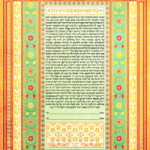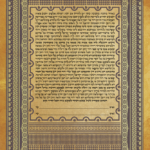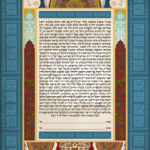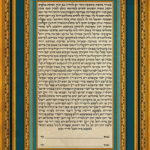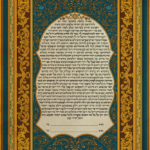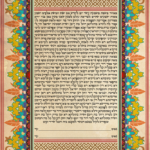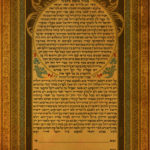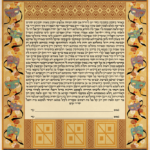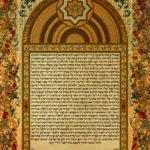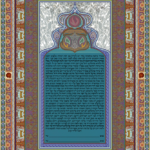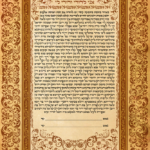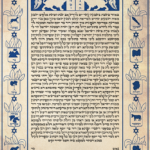Historical
The Historical Ketubot Collection is a collection of Ketubot inspired by the Ketubah Art of our ancestors.
-
The Shiraz Ketubah
$290.00
The Jews of Persia date back to Biblical times, the Babylonian Captivity, as well the annals of Greek history which verify much of our Biblical history. Our relationship with the gentile Persians has been complicated and difficult for as long as our Jewish memory goes back.
But the Jews of Persia have long adopted Iranian visual customs and styles, from the domes to the Isfahani look — and the bright colors and flowery flourishing. The Shiraz Ketubah is a recreation of the traditional Persian Jewish aesthetic elements and is the perfect Ketubah for the couple wanting to remember and respect our Persian heritage.
See This Ketubah See This Ketubah -
The Polish Ketubah
$290.00
From Kraków to Lublin, Poland was at the heart of Jewish life for almost a thousand years, and still lives in the collective Jewish imagination. From the classic chederim to the birth of the Chassidic movement to the pain of the Cossack invasions to the Pale of Settlement, the Jews of Poland experienced a substantial portion of the most recent millennium of Jewish history.
See This Ketubah See This Ketubah
The traditional Ketubot of the Polish Jews were simple but often with a few key symbols, notably, often the Jewish stars in the corners of the Ketubah. The Polish Ketubah is perfect a Jew, whose family lived in Poland, honoring the traditional Ketubot of the Polish Je -
The Tehran Ketubah
$290.00
Persian Jews have been known for their tradition of flowery art since ancient times, particularly in Tehran, Isfahan and Shiraz. Centuries of influence of cultures from the entire region as the Persian Jews led the Persian trading empires helped the traditional Persian Jewish artistic style incorporate elements from the Arabic and Indian styles nearby.
The Tehran Ketubah is a recreation of a traditional Persian Ketubah, and includes the core elements consistently found in Persian Ketubot, including, above all the extreme flourishes and ornamentation.
See This Ketubah See This Ketubah -
The Persian II Ketubah
$290.00
The Persian II Ketubah is a distinctive Ketubah, nothing like the Ketubot of any other Jewish community, ancient or modern. This Ketubah contains a beautiful vintage style, blending traditional Ketubah design with high-quality material. This Ketubah is perfect for the couple that wants something traditional with a great quality.
See This Ketubah See This Ketubah -
The Persian Ketubah
$290.00
The Jews have been an integral part of the Persian Empire since, at least, the ancient historical and biblical era of Cyrus, who let us practice our religion and rebuild our temple. The Persian Jews have a unique style, visible in the everything from the architecture to the style of liturgy, that combines thousands of years of Judaism with thousands of years of Persian culture.The Persian Ketubah is a distinctive Ketubah, nothing like the ketubot of any other Jewish community, ancient or modern. The Persian Ketubah is in the deep, rich colors, traditional in the Persian communities; and contains the decorative flair and patterns associated with the Persian Jewish community. The metaphorical frame around the deep aquamarine center that holds the Ketubah text is also a common element in traditional Persian Ketubot.See This Ketubah See This Ketubah
-
The Kermanshah Ketubah
$290.00
The city of Kermanshah was one of the great centers of the Jewish Persian world. From Nathan Habavly’s documentation of the Jewish world there in the 10th century to the founding of the Judeo-Persian newspaper Ha-Haim there in the 20th century, Kermanshah has been one of the most under-rated Jewish cities of the last thousand years.
The style of the Ketubot of Kermanshah is ancient and beautiful. The Ketubot of Kermanshah were never as opulent as some of the other Persian Ketubot, but they were decorated in the Persian-Jewish tradition. This Ketubah is a perfect mix of the eastern and western Jewish traditions.
See This Ketubah See This Ketubah -
The Moroccan Ketubah
$290.00
Jews have been a small but constant community in Morocco, since the destruction of the Second Temple. In Morocco for centuries, the Jews mixed heavily with the local Arab population — influencing the Jewish Moroccan dialects, traditional foods, and even the tunes of their classic Jewish prayers.The Moroccan Ketubah is based on the traditional Ketubot of the Moroccan Jews, particularly their mid 19th century style of Ketubot. In this Ketubah, you can see the subtle Arabic influence on the Moroccan Jewish style. The Horseshoe arch is an important architectural feature that is represented in this Ketubah. The text is decorated on the top with an elaborate representation of the voussoir, adding an importance and glamour to the text. It frames the texts and incorporates the seventh sheva brachot above and below.
See This Ketubah See This Ketubah -
The Hamadan Ketubah
$290.00
Hamadan is a Persian city in which Jews have lived since Biblical times (in the Bible, it is known as Ahmatha). The city has been a center of Jewish action consistently since, with Yehuda of Hamad leading a rebellion against the Arab government in the mid-10th century, and the Jewish poet Shahin died there.
Hamadan, tradition has it, where Mordechai and Esther are buried. The Hamadan Ketubah, acknowledging that tradition, has subtle nods to Purim, such as the masks decorating the sides. The Hamadan Ketubah is perfect for the partners who place the power of Purim in their passions.
See This Ketubah See This Ketubah -
The Amsterdam Ketubah
$290.00
The Jews were prominent in Amsterdam ever since they were expelled from France in 1325 and found refuge with the Dutch. The community grew to its golden years after the Expulsion from Spain led many Spanish Jews to find safety in Amsterdam as well. In the Jewish Netherlands, a unique intermingling of the Sephardi and Ashkenazim was born: intermarriage between these groups was common, and, due to the lack of Rabbis, the two often prayed together. Indeed, even in Dutch today, many Yiddish words are common — a testament to the Jewish influence in Holland throughout the centuries.In the Amsterdam Ketubah, this unique mixture of the Sephardi and Ashkenazim in Amsterdam clearly reveals itself. The elaborate patterns of the Sephardi tradition combine with the reserve of the Ashkenazi tradition, to create a magnificent historical Ketubah.See This Ketubah See This Ketubah
-
The Susa Ketubah
$290.00
Susa (“Shushan” in the Bible) is one of the ancient cities of the Jews of Persia. As the Capital of the Persian Empire in the era of the Bible, it was the home of not just thousands of Jews, but of the administration of the Persian empire. But perhaps most importantly, Susa is, of course, where, according to our tradition, the Prophet Daniel is buried.
The Ketubot of Susa are in the traditional Persian Ketubah style, with all of the ornamentation that is customary. Deeply influenced by the ancient Persian Isfahani aesthetic, the Ketubah merges the Persian style with the elements of the Ketubah and Judaism as well, including the six pomegranates around the edge of the Ketubah and the four chais in the four corners of the inner frame.
See This Ketubah See This Ketubah -
The Modena Italian Ketubah
$290.00
The Jews of Modena were the bankers (under the protection of the House of Este) and scribes, particularly the Kabbalistic scribes, since 1025. The Jewish tradition of Modena is rich and varied: the Jews were expelled from Bologna and other parts of Italy and escaped to the safety of Modena; yet Modena still required a Ghetto. They were the heart of the “Italkim,” the Jews of Italy.The tradition of the Ketubot from Modena is one of the greatest remaining gifts to modern Jewry from Modena. The Ketubot of Modena were elegant yet embellished — a perfect combination representing the ups-and-downs of the traditional Jewish life in Modena.The Modena Ketubah incorporates the elaborate details of the southern Sephardi Jews — and applies it to a more traditionally Ashkenazim format, where a simple frame holds the text. The use of one single color was popular in the early sixteenth century, as pigments were scarce, and the color red was the most appropriate option when writing on parchmentSee This Ketubah See This Ketubah
-
The Bucharest Ketubah
$290.00
Jews have been living in Romania since the 16th century; first the Jewish Turkish merchants first settled there, followed by waves of Ashkenazim over the centuries. The Jews of Bucharest have both suffered misfortunes and flourished profoundly at different eras during the last half-millennium in and around Bucharest, Moldovia and Walachia.
The Romanian Jewish tradition of Ketubah art is one of the best of the European and Ashkenazi Jews. The Ketubot of Bucharest often traditionally included references to the twelve tribes of Israel (such as the names and symbols of the 12 tribes aligning the columns of the Bucharest Ketubah) and the blue that is now so powerfully associated with Judaism.
See This Ketubah See This Ketubah

